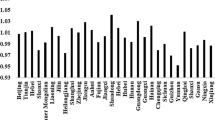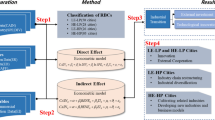Abstract
Environmental policies play an important role in the process of industrial low-carbon transition in developing countries. From the perspective of the impact condition and mechanisms, we discuss how to improve their effectiveness to give full play to the positive impact of environmental regulations. Based on provincial industrial data from 2003 to 2019 in China, this study uses a threshold regression model and endogenous regression to reveal the impact condition and mechanisms of environmental regulations on industrial low-carbon transition. The results suggest that (1) technological innovation capability and cost-bearing capacity are the key conditions for environmental regulations to exert a positive impact on low-carbon transition. (2) Environmental regulations have a positive impact on low-carbon transition through technological innovation (technology), resource reallocation (capital), and skill premium (labor). Research on the implementation conditions and mechanisms of environmental regulations will help policy-makers formulate appropriate and reasonable environmental regulations and eliminate the obstacles between environmental regulations and low-carbon transition, while an assessment of China’s environmental policies will provide a reference for environmental governance in other developing countries.


Similar content being viewed by others
Data availability
Supplementary data to this article can be provided.
Notes
Data source: 2020BP World Energy Statistics Yearbook.
The first external problem is the problem of financial risks. Green innovation activities have the characteristics of long time, high risk, and new projects, and the support in the financial field is insufficient. The second problem is that the return of pollution control is mainly beneficial to society, with the private sector lacking the motivation to research and develop innovation and to bear the cost, resulting in a lack of green innovation. These externalities require the government to enforce environmental policies and to effectively intervene (Ouyang et al. 2020).
Referring to the carbon emission accounting method of CEADs, only the emission of cement production is considered, because according to the research of Guan et al. (2021), the carbon emission of cement production in China accounts for 70%.
Data source: White Paper on China's Energy Development in the New Era.
Li Y.2016. Accelerating technological transformation and improving supply efficiency, Economic Daily, 11th Edition, January 13.
References
Acemoglu D, Aghion P, Bursztyn L, Hemous D (2012) The environment and directed technical change. Am Econ Rev 102(1):131–66
Becker R, Henderson V (2000) Effects of air quality regulations on polluting industries. J Polit Econ 108(2):379–421
Berman E, Bui LTM (2001) Environmental regulation and labor demand: evidence from the south coast air basin. J Public Econ 79(2):265–295
Carreira C, Teixeira P (2008) Internal and external restructuring over the cycle: a firm-based analysis of gross flows and productivity growth in Portugal. J Prod Anal 29(3):211–220
Cheng Z, Kong S (2022) The effect of environmental regulation on green total-factor productivity in China’s industry. Environ Impact Asses Rev 94:106757
Chen S, Chen D (2018) Haze pollution, government governance and high-quality economic development. Eco Res 53(2):15
Creti A, Sanin ME (2016) Does environmental regulation create merger incentives? Energ Policy 105(6):618–630
Dong F, Li J, Zhang X, Zhu J (2021) Decoupling relationship between haze pollution and economic growth: a new decoupling index. Ecol Indic 129:107859
Francesco V, Giovanni M, Davide C, David P (2018) Environmental regulation and green skills: an empirical exploration. J Assoc Environ Reso 5(4):713–753
Greenstone M (2002) The impacts of environmental regulations on industrial activity: evidence from the 1970 and 1977 clean air act amendments and the census of manufactures. J Polit Econ 110(6):1175–1219
Greenstone M, List JA, Syverson C (2012) The effects of environmental regulation on the competitiveness of US manufacturing. NBER Working Paper, No.w18392
Guan Y, Shan Y, Huang Q, Chen H, Wang D, Hubace K (2021) Assessment to China’s recent emission pattern shifts. Earth’s Future 9(11):1–13
Guo Q, Luo K (2021) The spatial convergence and drivers of environmental efficiency under haze constraints - evidence from China. Environ Impact Assess Rev 86:106513
Han C, Sang R (2018) Enterprise product conversion and product quality improvement under the constraints of environmental regulations. China Ind Eco 2:43–62
Han C, Zhang W, Feng Z (2017) How to “eliminate” resource mismatch in environmental regulation – based on the analysis of China’s first binding pollution control. China Ind Eco 04:115–134
Hansen BE (1999) Threshold effects in non-dynamic panels: Estimation, testing, and inference. J Econ 93(2):345–368
IPCC (2006) Guidelines for National Greenhouse Gas Inventories, Prepared by the National Greenhouse Gas Inventories Programme
Jin W, Gao S, Pan S (2023) Research on the impact mechanism of environmental regulation on green total factor productivity from the perspective of innovative human capital. Environ Sci Pollut Res 30(1):352–370
Ley M, Stucki T, Woerter M (2016) The impact of energy prices on green innovation. The Energ J 37(1):41–75
Li G, Gao D, Li Y (2022) Dynamic environmental regulation threshold effect of technical progress on green total factor energy efficiency: evidence from China. Environ Sci Pollut Res 6:29–32
Li L, Hong X, Peng K (2019) A spatial panel analysis of carbon emissions, economic growth and high-technology industry in China. Struct Change Econ Dyn 49:83–92
Liu C, Ma C, Xie R (2020) Structural, innovation and efficiency effects of environmental regulation: evidence from China’s carbon emissions trading pilot. Environ Resour Econ 75(4):741–768
Liu M, Tan R, Zhang B (2021) The costs of “blue sky”: environmental regulation, technology upgrading, and labor demand in China. J Dev Eco 150:102610
Liu W, Tong J, Yue X (2016) How does environmental regulation affect industrial transformation? A study based on the methodology of policy simulation. Math Probl Eng 3:1–10
Liu Z, Guan D, Wei W, Davis SJ, Ciais P, Bai J (2015) Reduced carbon emission estimates from fossil fuel combustion and cement production in China. Nature 524:335–338
Ouyang X, Li Q, Du K (2020) How does environmental regulation promote technological innovations in the industrial sector? Evidence from Chinese provincial panel data. Energ Policy 139:111310
Pekovic S, Bouziri A (2021) Overcoming obstacles to innovation: can environmental management practices help? Knowl Man Res Pract 1:1–16
Porter ME, Linde C (1995) Toward a new conception of the environment-competitiveness relationship. J Econ Perspect 9(4):97–118
Postula M, Radecka-Moroz K (2020) Fiscal policy instruments in environmental protection. Environ Impact Asses Rev 84:106435
Shi X, Xu Z (2018) Environmental regulation and firm exports: evidence from the eleventh five-year plan in China. J Environ Econ Manage 89:187–200
Tombe T, Winter J (2015) Environmental policy and misallocation: the productivity effect of intensity standards. J Environ Econ Manag 72:137–163
Wang A, Hu S, Lin B (2021) Can environmental regulation solve pollution problems? Theoretical model and empirical research based on the skill premium. Energ Econ 94:105068
Walker WR (2011) Environmental regulation and labor reallocation: evidence from the clean air act. Am Econ Rev 101(3):442–447
Wernerfelt BA (1984) Resource-based View of the Firm. Strateg Manag J 5(2):171–180
Xie J, Liao H (2017) Research on the impact of environmental regulation on export quality from the perspective of technological innovation – empirical analysis based on dynamic panel data of manufacturing industry. China Soft Sci 08:55–64
Xu M, Wu J (2020) Can Chinese-style environmental collaboration improve the air quality? A quasi-natural experimental study across Chinese cities. Environ Impact Assess Rev 85:106466
Xu Y, Qi Y (2017) Re-assessment and mechanism test of the impact of environmental regulation on enterprise productivity. Financ Trade Eco 06:147–161
Yan Y, Zhang X, Zhang J, Li K (2020) Emissions trading system (ETS) implementation and its collaborative governance effects on air pollution: The China story. Energ Policy 138:111282
Yu D, Sun T (2017) Environmental regulation, skill premium and international competitiveness of manufacturing industry. China Ind Eco 05:35–53
Zhao J, Jiang Q, Dong X, Dong K, Jiang H (2022) How does industrial structure adjustment reduce CO2 emissions? Spatial and mediation effects analysis for China. Energ Econ 105:105704
Zhou Q, Zhong S, Shi T, Zhang X (2021) Environmental regulation and haze pollution: neighbor-companion or neighbor-beggar? Energ Policy 151(3):112183
Zhou Q, Zhang X, Shao Q, Wang X (2019) The non-linear effect of environmental regulation on haze pollution: empirical evidence for 277 Chinese cities during 2002–2010. J Environ Manage 248:1–12
Zhang Y, Song L (2019) Export quality effect of environmental regulation and innovation: who plays a more important role in technological development and technological transformation. Economic Sci 2:53–65
Zhong S, Xiong Y, Xiang G (2021) Environmental regulation benefits for whom? Heterogeneous effects of the intensity of the environmental regulation on employment in China. J Environ Manage 281:111877
Funding
The work is supported by the National Soft Science Project of State Forestry and Grassland Administration (Grant No. 2019131039); by the Doctoral Research Fund, Northwest A&F University (Yangling) (Grant No. 109022008); by the 67th batch of projects supported by National Postdoctoral Science Foundation of China (Grant No. 2020M673498); by the Social Science Foundation of Shaanxi (Grant No. 2020D021); and by the key project of ecological space governance in Shaanxi Province (2022HZ1845).
Author information
Authors and Affiliations
Contributions
Yongwang Zhang: conceptualization, software, methodology, writing—original draft, data curation, formal analysis, funding acquisition. Minjuan Zhao: formal analysis, funding acquisition, review and editing.
Corresponding author
Ethics declarations
Ethical approval
This study does not involve ethical issues, so ethical approval is not provided.
Consent to participate
All authors of this study consent to participate.
Consent for publication
All authors of this study consent to publish in your journal.
Competing interests
The authors declare no competing interests.
Additional information
Responsible Editor: Roula Inglesi-Lotz
Publisher's note
Springer Nature remains neutral with regard to jurisdictional claims in published maps and institutional affiliations.
Rights and permissions
Springer Nature or its licensor (e.g. a society or other partner) holds exclusive rights to this article under a publishing agreement with the author(s) or other rightsholder(s); author self-archiving of the accepted manuscript version of this article is solely governed by the terms of such publishing agreement and applicable law.
About this article
Cite this article
Zhang, Y., Zhao, M. Regulation and decarbonization: how can environmental regulations more effectively facilitate industrial low-carbon transitions?. Environ Sci Pollut Res 30, 93213–93226 (2023). https://doi.org/10.1007/s11356-023-28302-5
Received:
Accepted:
Published:
Issue Date:
DOI: https://doi.org/10.1007/s11356-023-28302-5




